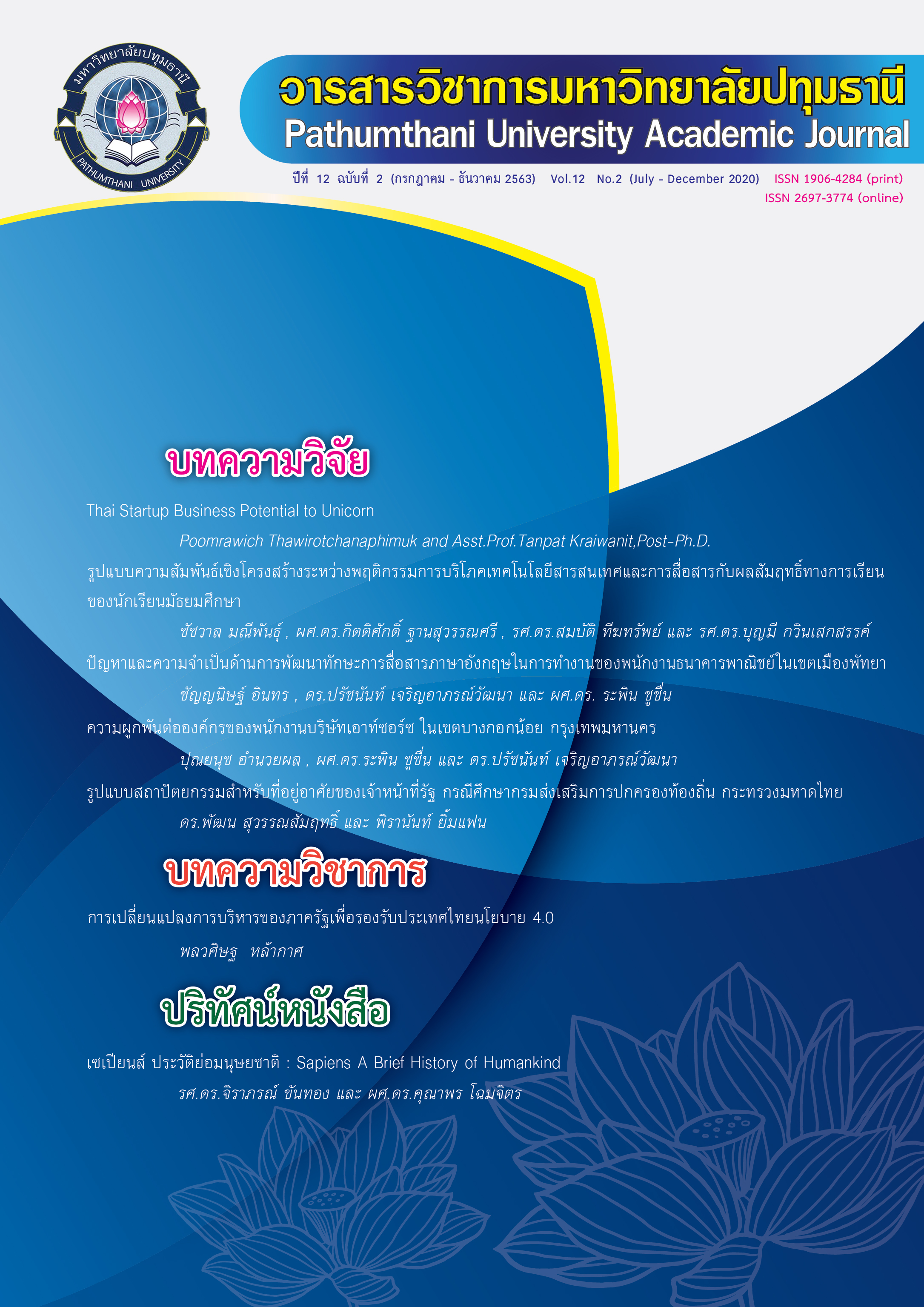THE CREATIVE LEADSHIP OF SCHOOL ADMINISTRATIOORS UNDER THE SECONDARY EDUCATIONAL SERVICE AREA OFFICE 3
Keywords:
creative leadership, school administrators, Secondary Educational Service Area Office 3Abstract
This study aimed 1) to investigate the creative leadership of school administrators under the Secondary Educational Service Area Office 3, and 2) to explore the development approach of the creative leadership of school administrators under the Secondary Educational Service Area Office 3. Research samples included 346 teachers in the schools under the Secondary Educational Service Area Office 3, derived from simple random sampling in the academic year 2019. The interview's key informants consisted of six school administrators under the Secondary Educational Service Area Office 3. The instruments for data collection were questionnaires and interview forms. The researcher employed the statistics included frequency, percentage, mean, standard deviation, and content analysis, to analyze data. The results revealed that 1) the creative leadership of school administrators under the Secondary Educational Service Area Office 3 showed a high level in an overview. 2) The development approach of school administrators' creative leadership under the Secondary Educational Service Area Office 3 was conducted by five areas. 1) Vision consisted of integrity, transparency, accountability, distinct standing, direction, and school goals. 2) Flexibility referred to allowing workers to have freedom and discretion. The official could decide by own consideration in the duration of the assigned work according to the working schedule. 3) Imagination consisted of organizing personnel development projects, field trips, and internal creative activities to strengthen the organization's relationship. 4) Problem-solving ability consisted of quality educational management, a key goal of creating educational opportunities for children and young people to receive a quality education by local requirements, acceptance, and faith among students, parents, and communities. 5) The challenge was to promote the personnel's participation and engagement to create a long-term desire to work, creating organization loyalty, and building human relations and unity in work happily.
References
กิตติ์กาญจน์ ปฏิพันธ์. (2555). โมเดลสมการโครงสร้างภาวะผู้นำเชิงสร้างสรรค์ของผู้บริหารสถานศึกษาอาชีวศึกษา. ปริญญานิพนธ์ปริญญาดุษฎีบัณฑิต มหาวิทยาลัยขอนแก่น
กิตติ์กาญจน์ ปฏิพันธ์. (2556). ภาวะผู้นำเชิงสร้างสรรค์:สิ่งที่ควรค่าสำหรับทุกคนในอนาคต. ขอนแก่น: โรงพิมพ์คลังนานาวิทยา.
เกรียงศักดิ์ เจริญวงศ์ศักดิ์. (2550). ความคิดสร้างสรรค์. (พิมพ์ครั้งที่ 8). กรุงเทพฯ: ซัคเซสมีเดีย.
จารินี สิกุลจ้อย. (2556). ศึกษาภาวะผู้นำเชิงสร้างสรรค์ของผู้บริหารสถานศึกษา.มหาวิทยาลัยศรีนครินทรวิโรฒ ประสานมิตร, กรุงเทพฯ.
จันจิรา น้ำขาว. (2562). ภาวะผู้นำเชิงสร้างสรรค์ของผู้บริหารกับการบริหารงานวิชาการ ในโรงเรียนสังกัดสำนักงานเขตพื้นที่การศึกษามัธยมศึกษา เขต 6.บัณฑิตวิทยาลัย, มหาวิทยาลัยศิลปากร.
นเรศ บุญช่วย. (2554). การพัฒนาภาวะผู้นำเชิงสร้างสรรค์ของผู้บริหารสถานศึกษา. ดุษฎีนิพนธ์ การศึกษาดุษฎีบัณฑิต, สาขาวิชาการบริหารการศึกษา, บัณฑิตวิทยาลัย,มหาวิทยาลัยราชภัฎวไลย์อลงกรณ์
ทองคำ พิมพา. (2556). การศึกษาความสัมพันธ์ระหว่างวิสัยทัศน์และภาวะผู้นำการเปลี่ยนแปลงกับการบริหารงานวิชาการของผู้บริหารโรงเรียนมัธยมศึกษาจังหวัดอ่างทอง. กรุงเทพ: กศ.ม. การบริหารการศึกษา มหาวิทยาลัยศรีนครินทรวิโรฒ.
เบ็ญจมาศ หนูไชยทอง. (2555). ความสัมพันธ์ระหว่างภาวะผู้นำเชิงสร้างสรรค์ของผู้บริหารสถานศึกษากับประสิทธิผลของโรงเรียนตามความคิดเห็นของครู สังกัดสำนักงานเขตพื้นที่การศึกษาประถมศึกษาสุราษฎร์ธานี เขต 1:บัณฑิตวิทยาลัย. มหาวิทยาลัยราชภัฏสุราษฎร์ธานี.
เบ็ญจมาศ หนูไชยทอง. (2561). ความสัมพันธ์ระหว่างภาวะผู้นำเชิงสร้างสรรค์ของผู้บริหารสถานศึกษากับประสิทธิผลของโรงเรียนตามความคิดเห็นของครู สังกัดสำนักงานเขตพื้นที่การศึกษาประถมศึกษาสุราษฎร์ธานี เขต 1:บัณฑิตวิทยาลัย. มหาวิทยาลัยราชภัฏสุราษฎร์ธานี.
พิมลพรรณ เพชรสมบัติ. (2560). ทักษะการบริหารของผู้บริหารมหาวิทยาลัยเทคโนโลยีราชมงคลธัญบุรี จังหวัดปทุมธานี. ปทุมธานี: มหาวิทยาลัยเทคโนโลยีราชมงคลธัญบุรี.
ภรณ์ทิพย์ ปั้นก้อง. (2559). ภาวะผู้นำเชิงสร้างสรรค์เป็นคุณลักษณะที่สำคัญบริหารการศึกษา. จุฬาลงกรณ์มหาวิทยาลัย.
มัทนา วังถนอมศักดิ์. (2550). รูปแบบแรงจูงใจในการปฏิบัติงานของครู :มหาวิทยาลัยศิลปากร.กรุงเทพฯ.
วินา สุทธิโพธิ์. (2561). ภาวะผู้นำเชิงสร้างสรรค์ของผู้บริหารสถานศึกษาในโรงเรียน สังกัดสำนักงานเขตพื้นที่การศึกษาประถมศึกษาเลย เขต 2.วารสารวิทยาลัยสงฆ์นครลำปาง.
ศศิรดา แพงไทย. (2562). บทบาทของผู้บริหารสถานศึกษาในศตวรรษที่ 21. วารสารวิทยาลัยบัณฑิตเอเซีย. 6(1 ); (มกราคม – มิถุนายน). หน้า 7-11.
เสาวนี ตรีพุทธรัตน์. (2547). ปัจจัยองค์กรที่ส่งผลต่อความมีประสิทธิผลการนำหลักสูตรการศึกษาขั้นพื้นฐานใช้ในโรงเรียนสังกัดสำนักงานกรศึกษาขั้นพื้นฐานภาคตะวันออกเฉียงเหนือ.
วิทยานิพนธ์ ปร.ด. (การบริหารการศึกษา).ขอนแก่น : บัณฑิตวิทยาลัยมหาวิทยาลัยขอนแก่น.
Coste, T.G. (2009). Creative Leadership and Women. [online]. Available from :http://www.pptsearch.net/ details-creative-leadership-amp-women349420.html. [accessed 28 July 2020].
Couto, R. A., & Eken, ร. c. (2002). To give their gifts: Health, community and democracy.Nashville: Vanderbilt University Press.
Cronbach, L. J. (1970). Essentials of Psychological Test (5th ed.). New York: Harper Collins.
Delich, V. (2010). The Impact of Mercosur’s Sanitary and Phitosanitary Regime on itsMembers’ Institutional Dynamics. Journal of CMA Management, 79(2), 3-3.
Harris, A. (2009). Creative leadership. Journal of Management in Education, 23(1), 9-11.
Krejcie, R. V. & Morgan, D. W. (1970). Determining Sample Size for Research Activities.Educational and Psychological Measurement, 30(3), pp. 607-610.
Maxwell, J. A. (2012). Qualitative research design: An interactive approach.Qualitative research design: An interactive approach. Sage Publications.
Parker, J. p., & Begnaud, L. G. (2004). Developing creative leadership. Portsmouth, NH: Teacher Ideas Press.
Sousa, D.A. (2003). The Leadership Brain : How to Lead Today's Schools More Effectively. California : Sage.
Stoll, L., & Temperley, J. (2009). Creative leadership teams. Journal of Management inEducation, 23(1), 12-18.
Ubben, G. C., & Hughes, L. W. & C. G. Norris. (2010). The principal: Creative leadership for effective schools. Pearson Custom Education.
Downloads
Published
How to Cite
Issue
Section
License
บทความที่ได้รับการตีพิมพ์เป็นลิขสิทธิ์ของวารสารมหาวิทยาลัยปทุมธานี
ข้อความที่ปรากฎในบทความแต่ละเรื่อง เป็นความคิดเห็นส่วนตัวของผู้เขียน กองบรรณาธิการไม่จำเป็นต้องเห็นด้วยเสมอไป และไม่มีส่วนรับผิดชอบใด ๆ ถือเป็นความรับผิดชอบของผู้เขียนแต่เพียงผู้เดียว



